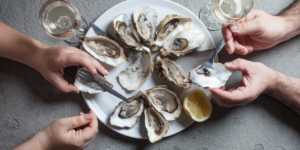Clams and oysters, two bivalve mollusks, have long been celebrated as ocean treasures in the culinary world. Their distinctive flavors, textures, and culinary versatility make them popular choices among seafood enthusiasts worldwide.

In this comprehensive comparison, we will explore the characteristics, nutritional value, environmental impact, and various culinary uses of clams and oysters. Whether you prefer the delicate sweetness of oysters or the tender brininess of clams, this exploration will enrich your understanding and appreciation of these ocean gems.
I. Anatomy and Classification:
Both clams and oysters belong to the Phylum Mollusca and the Class Bivalvia, characterized by having two hinged shells. However, they belong to different families and genera:
Clams (Family: Veneridae, Genus: Mercenaria, Ruditapes, etc.): Clams have a more symmetrical shell shape and can range in size from small littlenecks to larger quahogs. They are typically oval or round and have a foot that allows them to burrow into sand or mud.
Oysters (Family: Ostreidae, Genus: Crassostrea, Ostrea, etc.): Oysters have a more irregular and rough shell, often shaped like a cup or a flat fan. They are sessile, meaning they attach themselves to hard surfaces like rocks or other oyster shells and filter feed on plankton.
II. Flavor and Texture:
One of the primary distinctions between clams and oysters lies in their flavor and texture:
Clams: Clams have a tender and chewy texture with a briny, salty taste. They are often described as mildly sweet, especially when cooked. The flavor profile of clams varies depending on the species and their habitat, with some having a more pronounced oceanic taste.
Oysters: Oysters are renowned for their delicate and smooth texture, ranging from creamy to firm, depending on the variety. Their flavor is more complex, with a unique balance of brininess, sweetness, and subtle mineral notes, often referred to as “merroir.”
III. Nutritional Value:
Both clams and oysters are nutritious and offer numerous health benefits:
Clams: Clams are a rich source of protein, containing essential amino acids that support muscle and tissue repair. They are also high in iron, zinc, and selenium, which are crucial for immune function and metabolism.
Oysters: Oysters are nutrient-dense, providing an abundance of vitamins and minerals. They are an excellent source of zinc, vitamin B12, vitamin D, and omega-3 fatty acids, contributing to heart health and overall well-being.
IV. Culinary Uses:
Clams and oysters are used in a variety of culinary preparations, from simple raw presentations to elaborate dishes:
Clams: Clams are commonly enjoyed in clam chowders, pasta dishes, stews, and steamers. Their robust flavor and tender texture make them ideal for dishes that require longer cooking times, as they remain flavorful and tender.
Oysters: Oysters are often served raw on the half shell, allowing their natural flavors to shine. They are also grilled, fried, or used as a key ingredient in seafood stews, po’ boys, and seafood platters.
V. Environmental Impact:
The harvesting and consumption of both clams and oysters can have environmental implications:
Clams: Clams are often harvested sustainably through regulated fishing practices, as they are considered a renewable seafood resource. Responsible clam farming can help maintain healthy ecosystems by filtering water and improving water quality.
Oysters: Oysters are celebrated for their ecological benefits. Oyster reefs act as natural filters, removing impurities and improving water clarity. They also provide habitat for various marine species, contributing to biodiversity and coastal protection.
VI. Health Considerations:
As with any seafood, it is essential to consider potential health risks and precautions:
Clams: Some individuals may be allergic to shellfish, including clams, and should avoid consuming them. It is also essential to ensure that clams are properly cooked to minimize the risk of foodborne illnesses.
Oysters: Raw oysters may pose a risk of bacterial infections, particularly for individuals with compromised immune systems or specific health conditions. It is crucial to consume oysters from reputable sources and handle them safely to reduce the risk of illness.
VII. Culinary Preference:
The choice between clams and oysters often comes down to personal taste and culinary preference:
Clams: Clams’ briny and tender taste appeals to those who enjoy seafood with a subtle oceanic flavor. They are versatile and lend themselves well to a variety of dishes, making them a popular choice for many seafood lovers.
Oysters: Oysters’ delicate and complex flavor profile is beloved by aficionados seeking a unique taste experience. Their popularity as a delicacy is evident in raw oyster bars worldwide, where enthusiasts relish the opportunity to taste different oyster varieties.
In conclusion, clams and oysters share similarities as bivalve mollusks but offer distinct flavors, textures, and culinary uses. Whether you prefer the tender brininess of clams



